User-Aware Evaluation for Medium-Resolution Forest-Related Datasets in China: Reliability and Spatial Consistency
Abstract
:1. Introduction
2. Dataset Description
| Dataset | Period | Satellites | Resolution | Accuracy | Method |
|---|---|---|---|---|---|
| WorldCover (https://zenodo.org/record/5571936#.ZEjQ_Y9BxaR, accessed on 7 April 2023) | 2020 | Sentinel-2 Sentinel-1 | 10 m | OA: 74.4% Tree cover: PA: 89.9%, UA: 80.8% Mangroves: PA: 51.5%, UA: 68.6% | Gradient boosting decision tree (CatBoost) |
| Esri Land Cover (https://www.arcgis.com/apps/instant/media/index.html?appid=fc92d38533d440078f17678ebc20e8e2, accessed on 7 April 2023) | 2020 | Sentinel-2 | 10 m | OA: 85.96% Treecover: PA: 91.07%, UA: 90.35% | Deep learning (U-Net) |
| GlobeLand30 (http://www.globallandcover.com/home.html?type=data, accessed on 7 April 2023) | 2020 | Landsat HJ-1 GF-1 WFV | 30 m | OA: 85.72%; Kappa: 0.82 | Pixel- and object-based methods with knowledge |
| GLC_FCS30 (https://data.casearth.cn/sdo/detail/5fbc7904819aec1ea2dd7061, accessed on 7 April 2023) | 2020 | Landsat | 30 m | OA: 82.5%; Kappa:0.78 [35] | A local adaptive random forest |
| FROM-GLC10 (http://data.ess.tsinghua.edu.cn/fromglc2017v1.html, accessed on 7 April 2023) | 2017 | Sentinel-2 | 10 m | OA: 72.76% Forest: PA: 84.20%, UA: 83.47% | Random forest |
| Tree Cover (https://storage.googleapis.com/earthenginepartners-hansen/GFC-2021-v1.9/download.html, accessed on 7 April 2023) | 2020 | Landsat | 30 m | - | Bagged decision tree |
| Dataset | Definition |
|---|---|
| WorldCover | Tree cover: This class includes any geographic area dominated by trees with a cover of 10% or more. Other land cover classes (shrubs and/or herbs in the understory, built-up, permanent water bodies, …) can be present below the canopy, even with a density higher than trees. Areas planted with trees for afforestation purposes and plantations (e.g., oil palm, olive trees) are included in this class. This class also includes tree covered areas seasonally or permanently flooded with fresh water except for mangroves. Mangroves: Taxonomically diverse, salt-tolerant tree and other plant species which thrive in intertidal zones of sheltered tropical shores, “overwash” islands, and estuaries. |
| Esri Land Cover | Trees: Any significant clustering of tall (~15 m or higher) dense vegetation, typically with a closed or dense canopy; examples: wooded vegetation, clusters of dense tall vegetation within savannas, plantations, swamp, or mangroves (dense/tall vegetation with ephemeral water or canopy too thick to detect water underneath). |
| GlobeLand30 | Forest: It refers to the lands covered with trees, the top density of which occupies over 30%. Deciduous broadleaf forest, evergreen broadleaf forest, deciduous coniferous forest, evergreen coniferous forest, mixed forest, and sparse woodland the top density of which covers 10–30% are included in this category. |
| GLC_FCS30-2020 | Level 0 classification system: Forest |
| Fine classification system: Open evergreen broadleaved forest Closed evergreen broadleaved forest Open deciduous broadleaved forest (0.15 < fc < 0.4) Closed deciduous broadleaved forest (fc > 0.4) Open evergreen needle-leaved forest (0.15 < fc < 0.4) Closed evergreen needle-leaved forest (fc > 0.4) Open deciduous needle-leaved forest (0.15 < fc < 0.4) Closed deciduous needle-leaved forest (fc > 0.4) Open mixed leaf forest (broadleaved and needle-leaved) Closed mixed leaf forest (broadleaved and needle-leaved) | |
| FROM-GLC10 | Forest: [36] Trees observable in the landscape from the images. Forest has a distinct canopy texture on TM images. |
| Tree Cover | All vegetation taller than 5 m. |
3. Materials and Methods
3.1. Forest Dataset Processing
3.2. Sampling Strategy
3.3. Accuracy Assessment
4. Results
4.1. Spatial Consistency Analysis
4.2. Spatial Consistency Analysis
5. Discussions
5.1. Validity of Sampling Strategy and Label Initialization
5.1.1. The Comparison of Sampling Strategies
5.1.2. The Comparison of Label Initialization
5.2. Reasons for Inconsistency across Forest Datasets
5.3. Limitations of Point-Based Accuracy Metrics
5.4. Reflections on the Future of Forest Research
6. Conclusions
Author Contributions
Funding
Data Availability Statement
Acknowledgments
Conflicts of Interest
References
- Campbell, J.B.; Wynne, R.H. Introduction to Remote Sensing; Guilford Press: New York, NY, USA, 2011. [Google Scholar]
- Reinhold, A.; Wolff, G. Methods of representing the results of photo interpretation. Photogrammetria 1970, 25, 201–207. [Google Scholar] [CrossRef]
- France, M.; Hedges, P. A hydrological comparison of Landsat TM, Landsat MSS and black & white aerial photography. In Proceedings of the Remote Sensing for Ressources Development and Environmental Management. International Symposium, Enschede, The Netherlands, 25–29 August 1986; 1986; Volume 7, pp. 717–720. [Google Scholar]
- Kangas, A.; Maltamo, M. Forest Inventory: Methodology and Applications; Springer Science & Business Media: Berlin/Heidelberg, Germany, 2006; Volume 10. [Google Scholar]
- Zhang, X.; Long, T.; He, G.; Guo, Y.; Yin, R.; Zhang, Z.; Xiao, H.; Li, M.; Cheng, B. Rapid generation of global forest cover map using Landsat based on the forest ecological zones. J. Appl. Remote Sens. 2020, 14, 022211. [Google Scholar] [CrossRef]
- Belgiu, M.; Drăguţ, L. Random forest in remote sensing: A review of applications and future directions. ISPRS J. Photogramm. Remote Sens. 2016, 114, 24–31. [Google Scholar] [CrossRef]
- Gigović, L.; Pourghasemi, H.R.; Drobnjak, S.; Bai, S. Testing a New Ensemble Model Based on SVM and Random Forest in Forest Fire Susceptibility Assessment and Its Mapping in Serbia’s Tara National Park. Forests 2019, 10, 408. [Google Scholar] [CrossRef]
- Peng, X.; He, G.; She, W.; Zhang, X.; Wang, G.; Yin, R.; Long, T. A Comparison of Random Forest Algorithm-Based Forest Extraction with GF-1 WFV, Landsat 8 and Sentinel-2 Images. Remote Sens. 2022, 14, 5296. [Google Scholar] [CrossRef]
- White, J.C.; Coops, N.C.; Wulder, M.A.; Vastaranta, M.; Hilker, T.; Tompalski, P. Remote Sensing Technologies for Enhancing Forest Inventories: A Review. Can. J. Remote Sens. 2016, 42, 619–641. [Google Scholar] [CrossRef]
- Di Biase, R.M.; Fattorini, L.; Marchi, M. Statistical inferential techniques for approaching forest mapping. A review of methods. Ann. Silvic. Res. 2018, 42, 46–58. [Google Scholar]
- Banskota, A.; Kayastha, N.; Falkowski, M.J.; Wulder, M.A.; Froese, R.E.; White, J.C. Forest Monitoring Using Landsat Time Series Data: A Review. Can. J. Remote Sens. 2014, 40, 362–384. [Google Scholar] [CrossRef]
- Shimada, M.; Itoh, T.; Motooka, T.; Watanabe, M.; Shiraishi, T.; Thapa, R.; Lucas, R. New global forest/non-forest maps from ALOS PALSAR data (2007–2010). Remote Sens. Environ. 2014, 155, 13–31. [Google Scholar] [CrossRef]
- Liu, L.; Zhang, X.; Gao, Y.; Chen, X.; Shuai, X.; Mi, J. Finer-Resolution Mapping of Global Land Cover: Recent Developments, Consistency Analysis, and Prospects. J. Remote Sens. 2021, 2021, 5289697. [Google Scholar] [CrossRef]
- Venter, Z.S.; Barton, D.N.; Chakraborty, T.; Simensen, T.; Singh, G. Global 10 m Land Use Land Cover Datasets: A Comparison of Dynamic World, World Cover and Esri Land Cover. Remote Sens. 2022, 14, 4101. [Google Scholar] [CrossRef]
- Wang, J.; Yang, X.; Wang, Z.; Cheng, H.; Kang, J.; Tang, H.; Li, Y.; Bian, Z.; Bai, Z. Consistency Analysis and Accuracy Assessment of Three Global Ten-Meter Land Cover Products in Rocky Desertification Region—A Case Study of Southwest China. ISPRS Int. J. Geo-Inf. 2022, 11, 202. [Google Scholar] [CrossRef]
- Ding, Y.; Yang, X.; Wang, Z.; Fu, D.; Li, H.; Meng, D.; Zeng, X.; Zhang, J. A Field-Data-Aided Comparison of Three 10 m Land Cover Products in Southeast Asia. Remote Sens. 2022, 14, 5053. [Google Scholar] [CrossRef]
- Sun, W.; Ding, X.; Su, J.; Mu, X.; Zhang, Y.; Gao, P.; Zhao, G. Land use and cover changes on the Loess Plateau: A comparison of six global or national land use and cover datasets. Land Use Policy 2022, 119, 106165. [Google Scholar] [CrossRef]
- Wang, H.; Yan, H.; Hu, Y.; Xi, Y.; Yang, Y. Consistency and Accuracy of Four High-Resolution LULC Datasets—Indochina Peninsula Case Study. Land 2022, 11, 758. [Google Scholar] [CrossRef]
- Xu, Y.; Yu, L.; Feng, D.; Peng, D.; Li, C.; Huang, X.; Lu, H.; Gong, P. Comparisons of three recent moderate resolution African land cover datasets: CGLS-LC100, ESA-S2-LC20, and FROM-GLC-Africa30. Int. J. Remote Sens. 2019, 40, 6185–6202. [Google Scholar] [CrossRef]
- Congalton, R.; Gu, J.; Yadav, K.; Thenkabail, P.; Ozdogan, M. Global Land Cover Mapping: A Review and Uncertainty Analysis. Remote Sens. 2014, 6, 12070–12093. [Google Scholar] [CrossRef]
- Shi, W.; Zhao, X.; Zhao, J.; Zhao, S.; Guo, Y.; Liu, N.; Sun, N.; Du, X.; Sun, M. Reliability and consistency assessment of land cover products at macro and local scales in typical cities. Int. J. Digit. Earth 2023, 16, 486–508. [Google Scholar] [CrossRef]
- Dong, S.; Guo, H.; Chen, Z.; Pan, Y.; Gao, B. Spatial Stratification Method for the Sampling Design of LULC Classification Accuracy Assessment: A Case Study in Beijing, China. Remote Sens. 2022, 14, 865. [Google Scholar] [CrossRef]
- Galiatsatos, N.; Donoghue, D.N.M.; Watt, P.; Bholanath, P.; Pickering, J.; Hansen, M.C.; Mahmood, A.R.J. An Assessment of Global Forest Change Datasets for National Forest Monitoring and Reporting. Remote Sens. 2020, 12, 1790. [Google Scholar] [CrossRef]
- Feng, M.; Sexton, J.O.; Huang, C.; Anand, A.; Channan, S.; Song, X.-P.; Song, D.-X.; Kim, D.-H.; Noojipady, P.; Townshend, J.R. Earth science data records of global forest cover and change: Assessment of accuracy in 1990, 2000, and 2005 epochs. Remote Sens. Environ. 2016, 184, 73–85. [Google Scholar] [CrossRef]
- Hao, X.; Luo, S.; Che, T.; Wang, J.; Li, H.; Dai, L.; Huang, X.; Feng, Q. Accuracy assessment of four cloud-free snow cover products over the Qinghai-Tibetan Plateau. Int. J. Digit. Earth 2018, 12, 375–393. [Google Scholar] [CrossRef]
- Zhang, C.; Dong, J.; Ge, Q. Quantifying the accuracies of six 30-m cropland datasets over China: A comparison and evaluation analysis. Comput. Electron. Agric. 2022, 197, 106946. [Google Scholar] [CrossRef]
- Zanaga, D.; Van De Kerchove, R.; De Keersmaecker, W.; Souverijns, N.; Brockmann, C.; Quast, R.; Wevers, J.; Grosu, A.; Paccini, A.; Vergnaud, S.; et al. ESA WorldCover 10 m 2020 v100. 2021. Available online: https://zenodo.org/record/5571936#.Y0uZbnZBxaQ (accessed on 7 April 2023).
- Karra, K.; Kontgis, C.; Statman-Weil, Z.; Mazzariello, J.C.; Mathis, M.; Brumby, S.P. Global land use/land cover with Sentinel 2 and deep learning. In Proceedings of the 2021 IEEE International Geoscience and Remote Sensing Symposium IGARSS, Brussels, Belgium, 11–16 July 2021; pp. 4704–4707. [Google Scholar]
- Gong, P.; Liu, H.; Zhang, M.; Li, C.; Wang, J.; Huang, H.; Clinton, N.; Ji, L.; Li, W.; Bai, Y.; et al. Stable classification with limited sample: Transferring a 30-m resolution sample set collessscted in 2015 to mapping 10-m resolution global land cover in 2017. Sci. Bull. 2019, 64, 370–373. [Google Scholar] [CrossRef] [PubMed]
- Chen, J.; Chen, J.; Liao, A.; Cao, X.; Chen, L.; Chen, X.; He, C.; Han, G.; Peng, S.; Lu, M.; et al. Global land cover mapping at 30m resolution: A POK-based operational approach. ISPRS J. Photogramm. Remote Sens. 2015, 103, 7–27. [Google Scholar] [CrossRef]
- Jun, C.; Ban, Y.; Li, S. Open access to Earth land-cover map. Nature 2014, 514, 434. [Google Scholar] [CrossRef]
- Zhang, X.; Liu, L.; Chen, X.; Gao, Y.; Xie, S.; Mi, J. GLC_FCS30: Global land-cover product with fine classification system at 30 m using time-series Landsat imagery. Earth Syst. Sci. Data 2021, 13, 2753–2776. [Google Scholar] [CrossRef]
- Hansen, M.C.; Potapov, P.V.; Moore, R.; Hancher, M.; Turubanova, S.A.; Tyukavina, A.; Thau, D.; Stehman, S.V.; Goetz, S.J.; Loveland, T.R.; et al. High-resolution global maps of 21st-century forest cover change. Science 2013, 342, 850–853. [Google Scholar] [CrossRef]
- Zhang, X.; Liu, L.; Chen, X.; Xie, S.; Gao, Y. Fine Land-Cover Mapping in China Using Landsat Datacube and an Operational SPECLib-Based Approach. Remote Sens. 2019, 11, 1056. [Google Scholar] [CrossRef]
- Zhang, X.; Liu, L.; Zhao, T.; Gao, Y.; Chen, X.; Mi, J. GISD30: Global 30 m impervious-surface dynamic dataset from 1985 to 2020 using time-series Landsat imagery on the Google Earth Engine platform. Earth Syst. Sci. Data 2022, 14, 1831–1856. [Google Scholar] [CrossRef]
- Gong, P.; Wang, J.; Yu, L.; Zhao, Y.; Zhao, Y.; Liang, L.; Niu, Z.; Huang, X.; Fu, H.; Liu, S.; et al. Finer resolution observation and monitoring of global land cover: First mapping results with Landsat TM and ETM+ data. Int. J. Remote Sens. 2012, 34, 2607–2654. [Google Scholar] [CrossRef]
- National Forestry and Grassland Administration. China Forest Resources Report; Chinese Forestry Press: Beijing, China, 2020. [Google Scholar]
- Xu, X.; Li, B.; Liu, X.; Li, X.; Shi, Q. Mapping annual global land cover changes at a 30 m resolution from 2000 to 2015. Natl. Remote Sens. Bull. 2021, 25, 1896–1916. [Google Scholar] [CrossRef]
- Zhu, Z.; Gallant, A.L.; Woodcock, C.E.; Pengra, B.; Olofsson, P.; Loveland, T.R.; Jin, S.; Dahal, D.; Yang, L.; Auch, R.F. Optimizing selection of training and auxiliary data for operational land cover classification for the LCMAP initiative. ISPRS J. Photogramm. Remote Sens. 2016, 122, 206–221. [Google Scholar] [CrossRef]
- Ahmed, N.; Saha, S.; Shahzad, M.; Fraz, M.M.; Zhu, X.X. Progressive Unsupervised Deep Transfer Learning for Forest Mapping in Satellite Image. In Proceedings of the IEEE/CVF International Conference on Computer Vision, Montreal, BC, Canada, 11–17 October 2021; pp. 752–761. [Google Scholar]
- Yin, R.; He, G.; Wang, G.; Long, T.; Li, H.; Zhou, D.; Gong, C. Automatic Framework of Mapping Impervious Surface Growth With Long-Term Landsat Imagery Based on Temporal Deep Learning Model. IEEE Geosci. Remote Sens. Lett. 2022, 19, 2502605. [Google Scholar] [CrossRef]
- Xia, L.; Zhao, F.; Chen, J.; Yu, L.; Lu, M.; Yu, Q.; Liang, S.; Fan, L.; Sun, X.; Wu, S.; et al. A full resolution deep learning network for paddy rice mapping using Landsat data. ISPRS J. Photogramm. Remote Sens. 2022, 194, 91–107. [Google Scholar] [CrossRef]
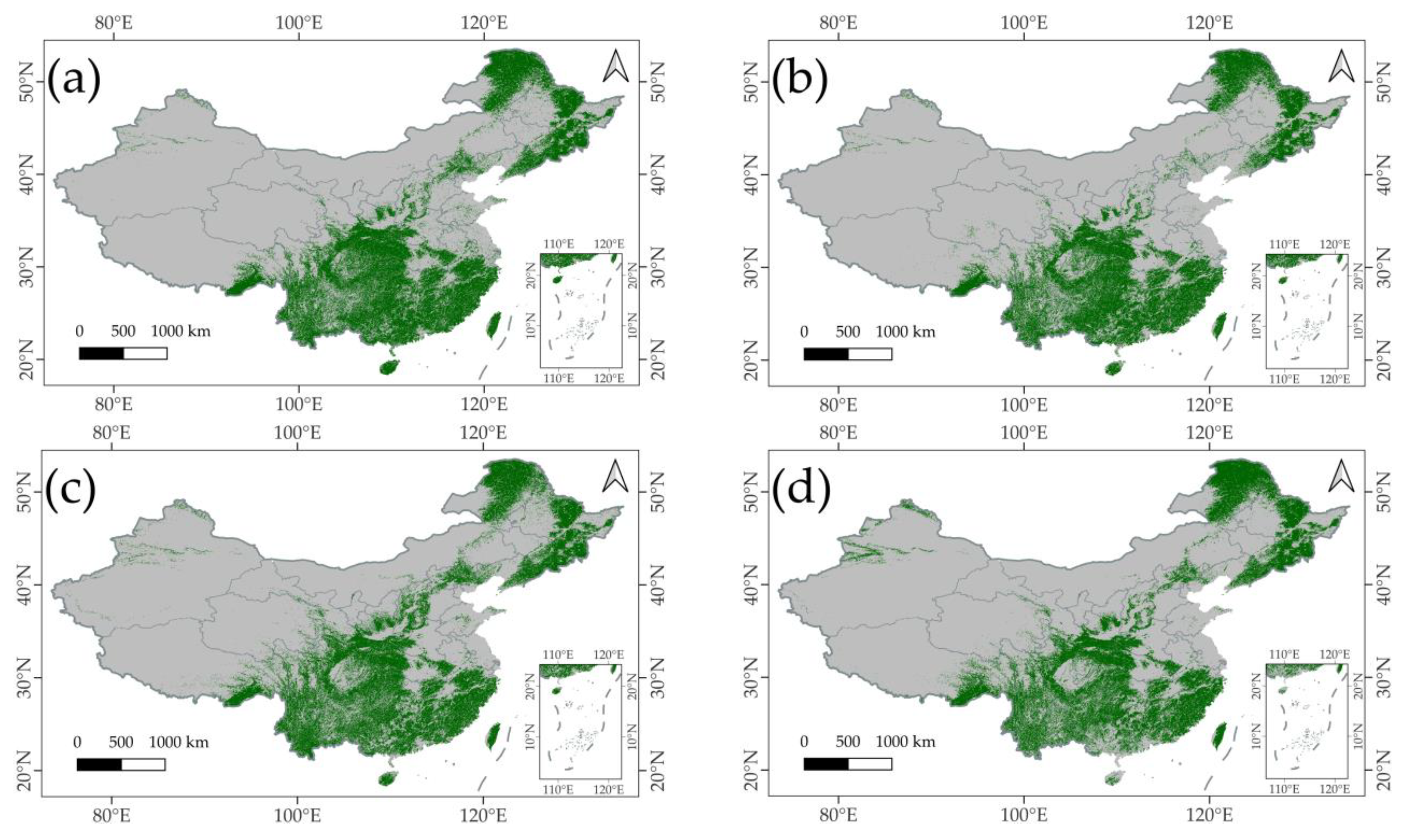


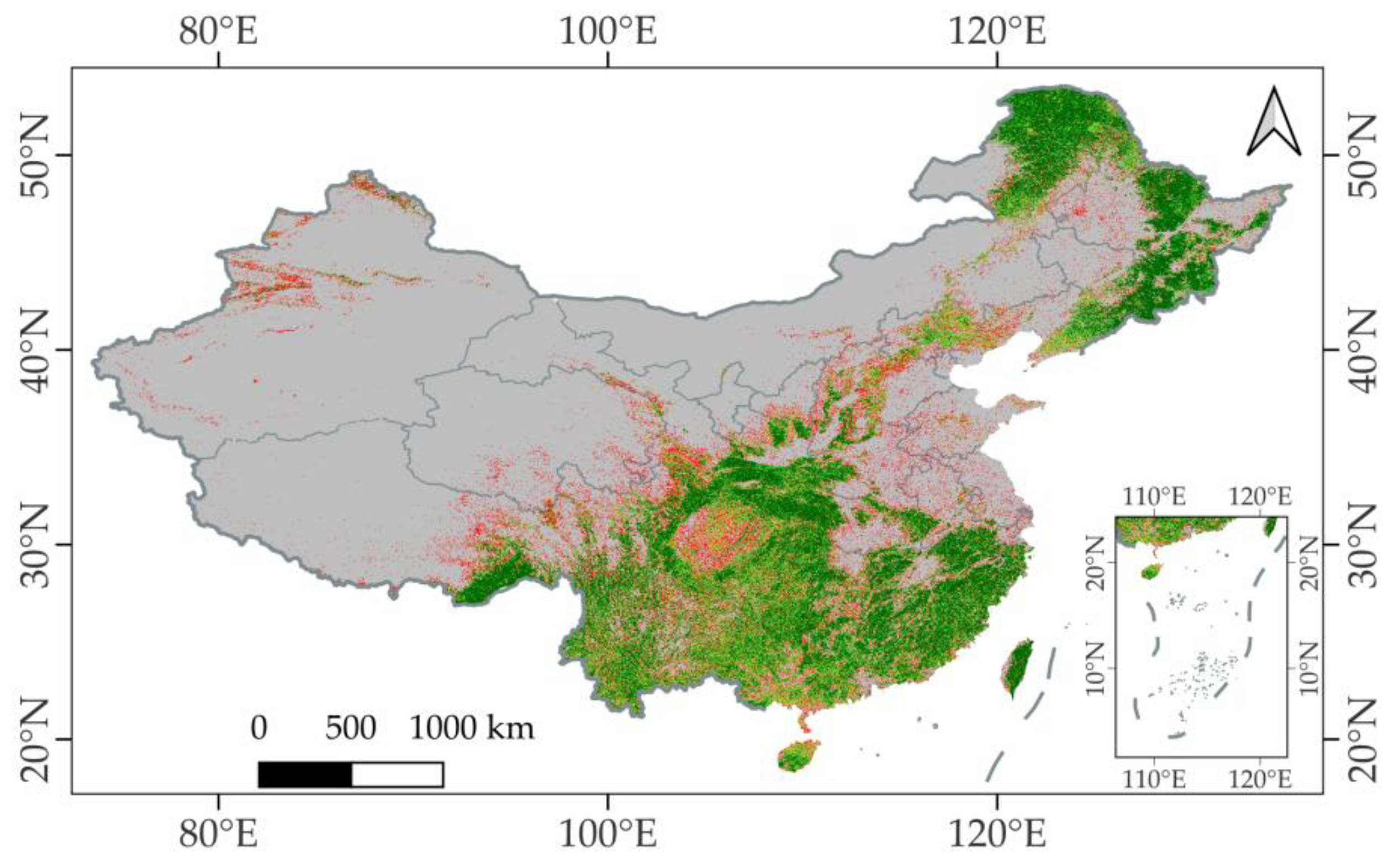
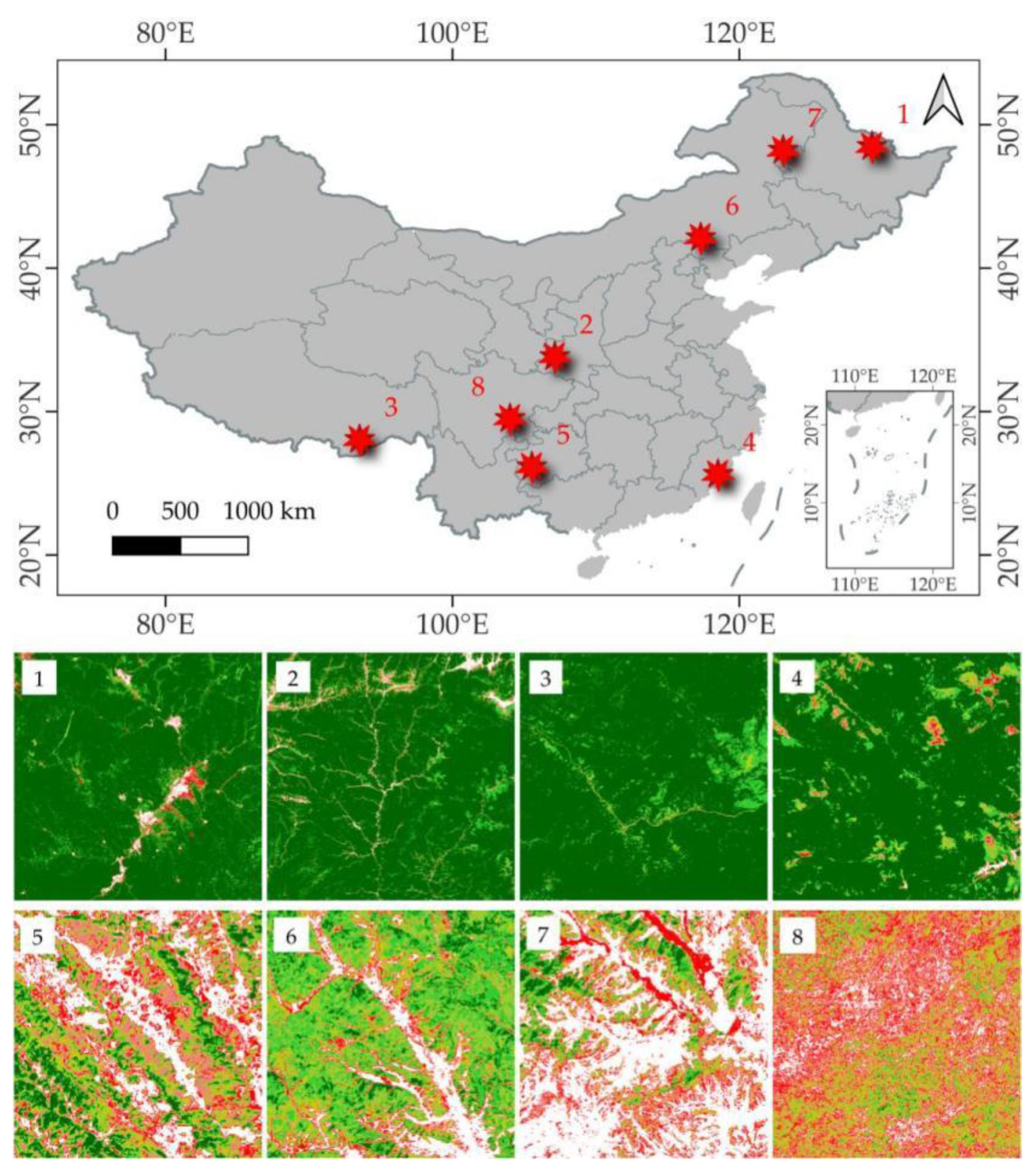
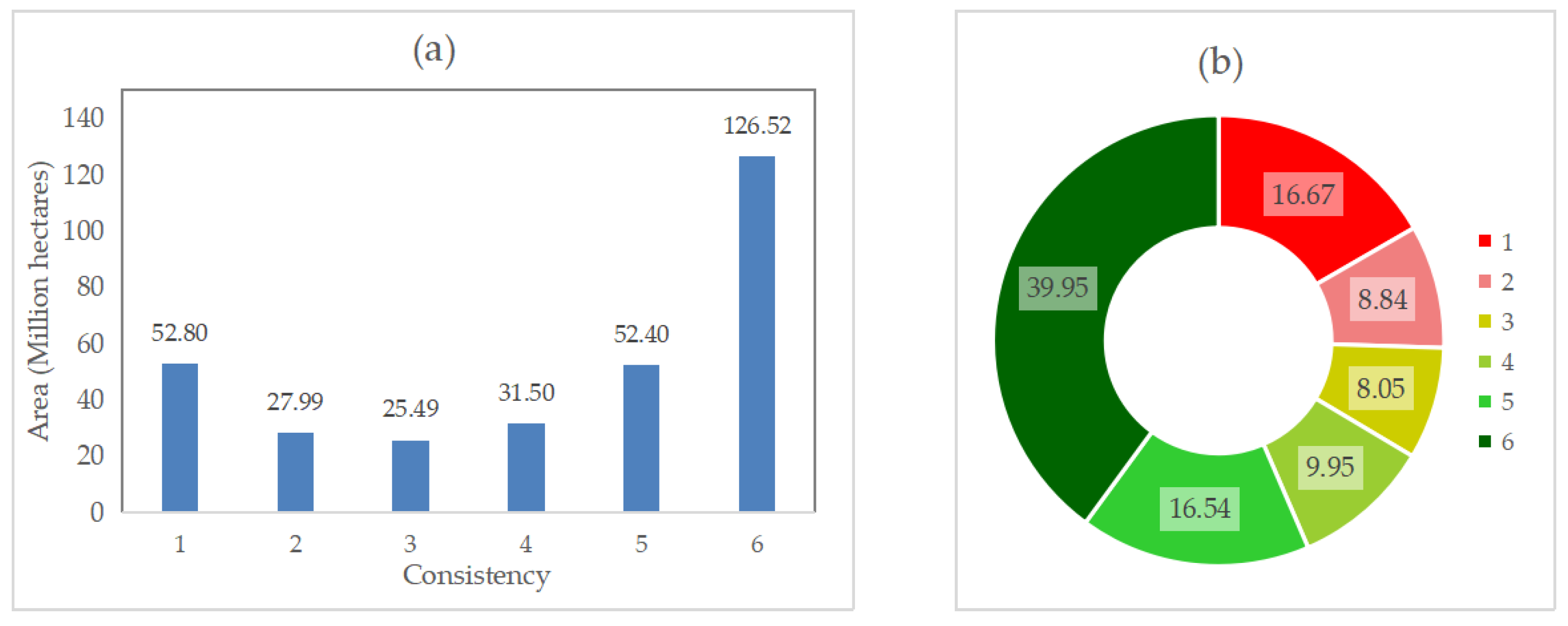

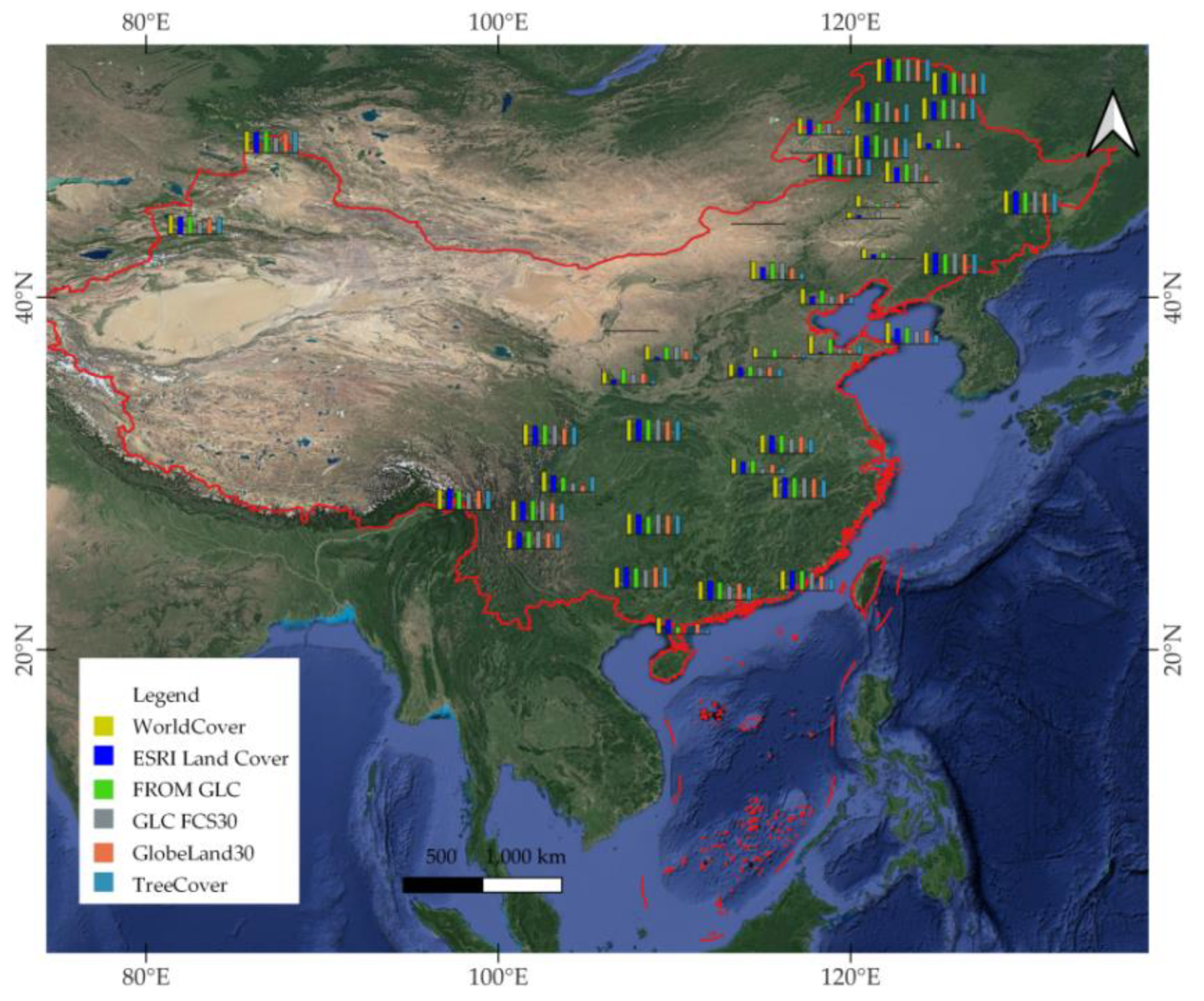




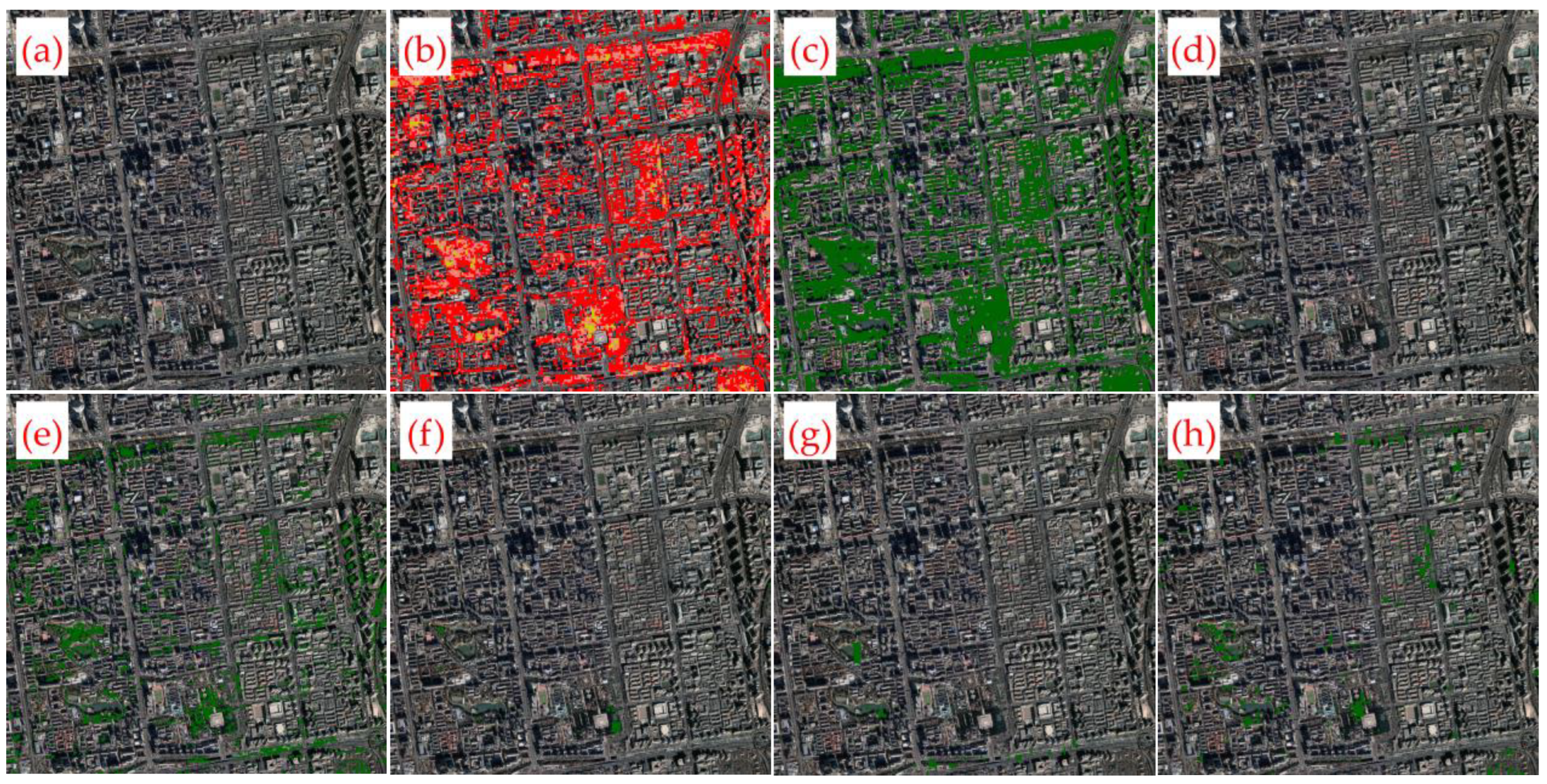
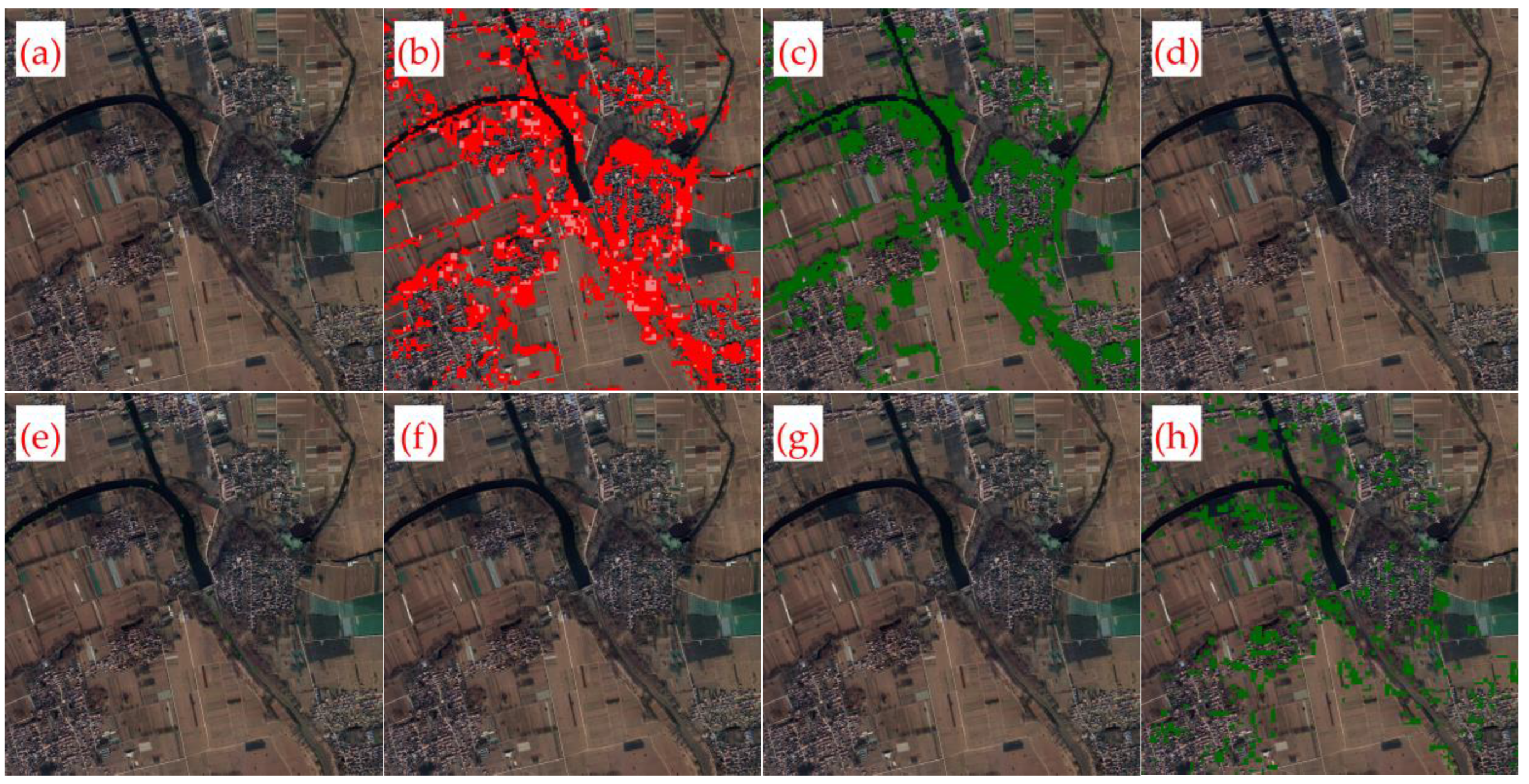


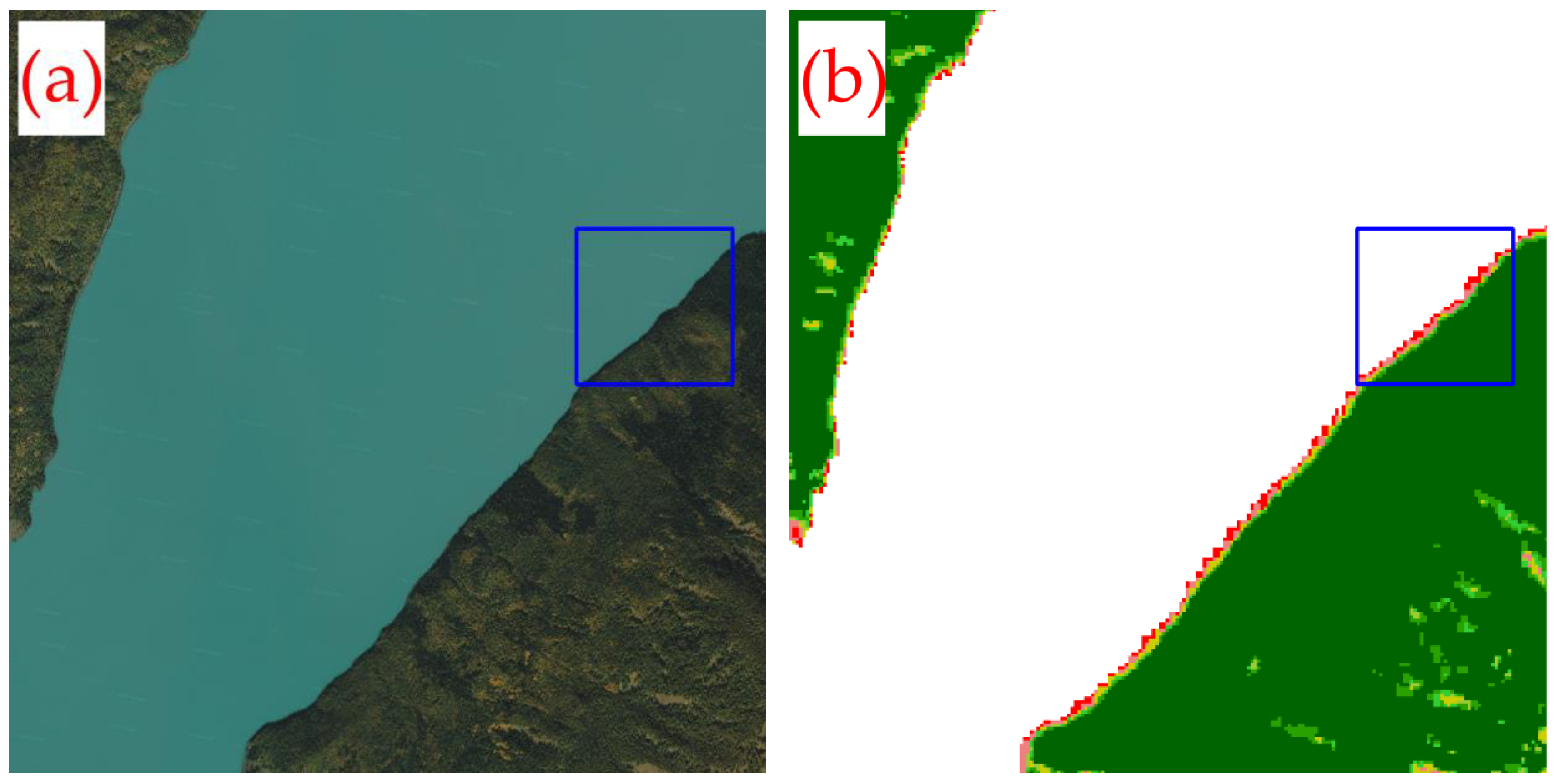
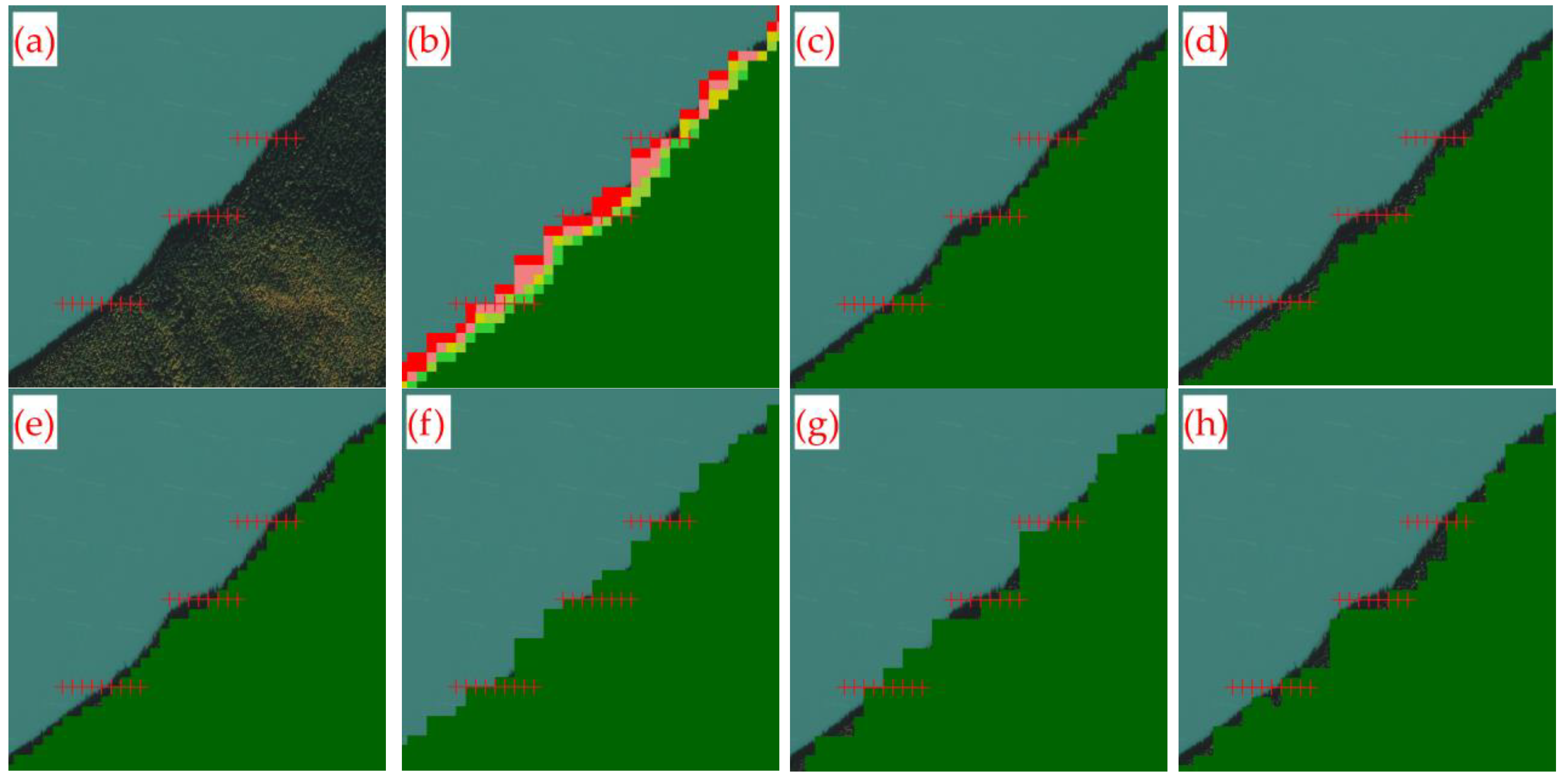
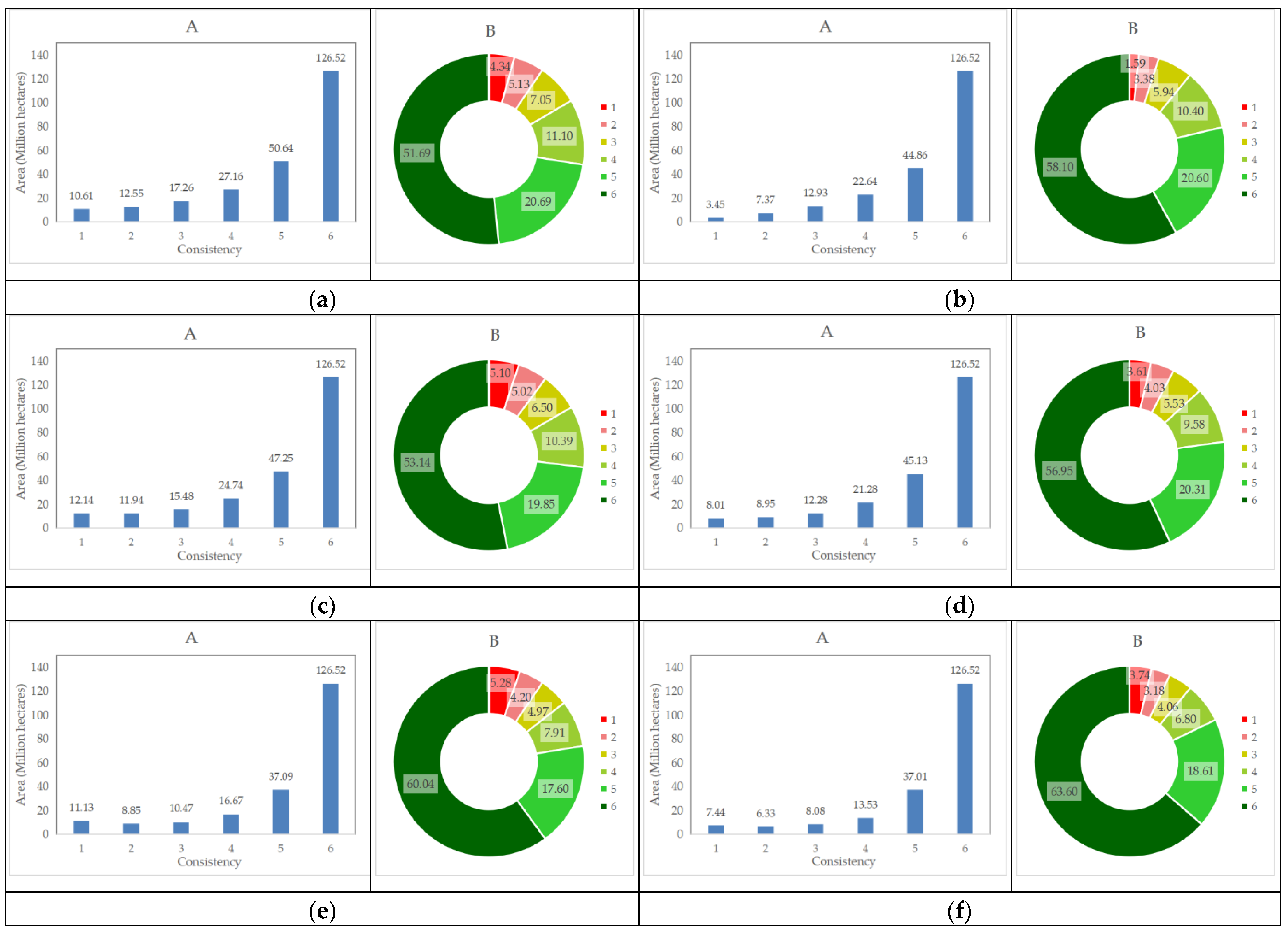
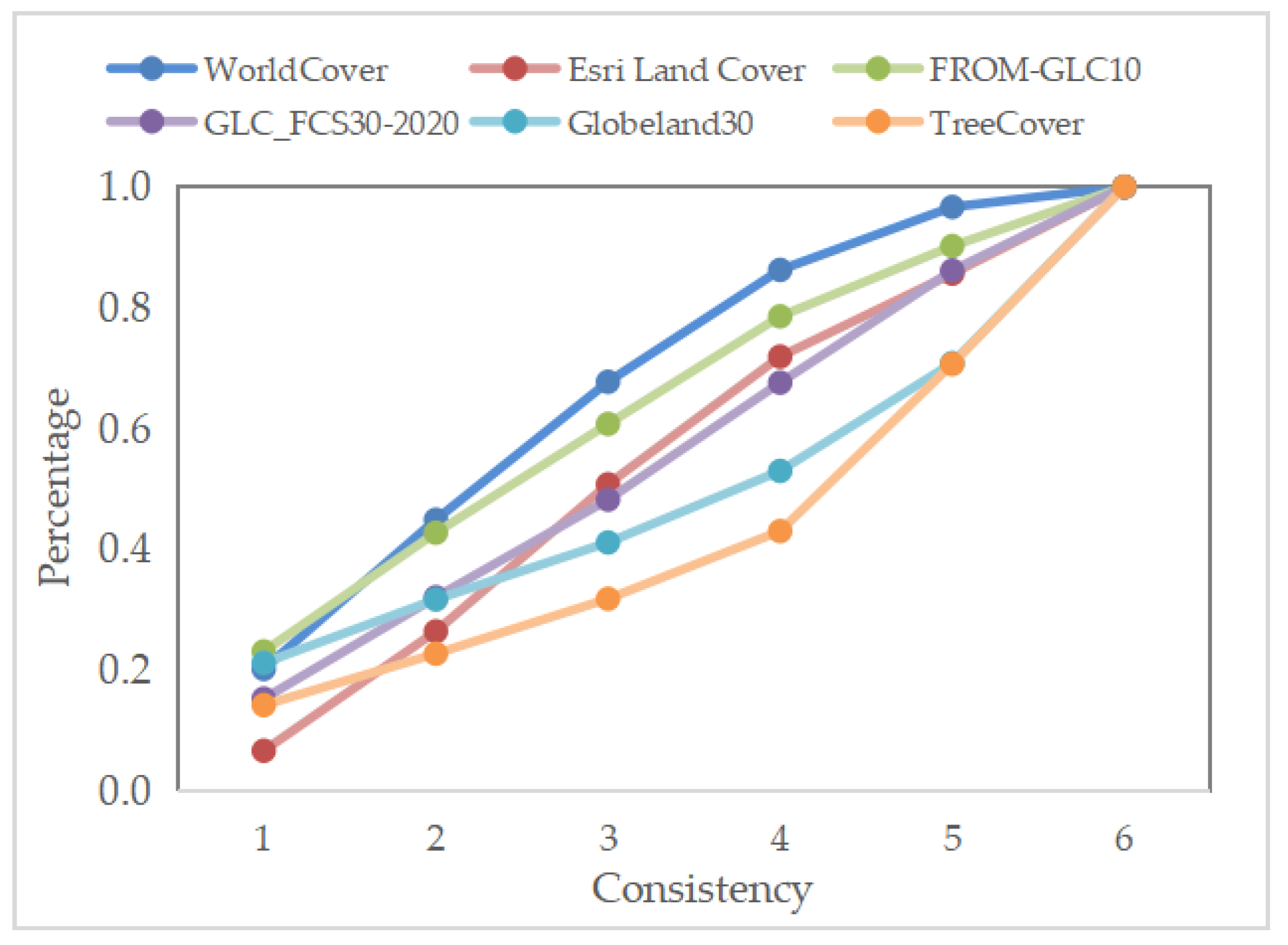
| TreeCover | GlobeLand30 | FROM-GLC10 | WorldCover | Esri Land Cover | GLC_FCS30-2020 | |
|---|---|---|---|---|---|---|
| FRC 1 | FRC | FRC | FRC | FRC | FRC | |
| - | Crop | Cropland | Cropland | Crops | Rainfed cropland | Irrigated cropland |
| - | Grassland | Grassland | Grassland | Grass | Herbaceous cover | Grassland |
| Sparse vegetation (fc < 0.15) | Sparse herbaceous (fc < 0.15) | |||||
| - | Shrubland | Shrubland | Shrubland | Scrub/shrub | Tree or shrub cover (Orchard) | Shrubland |
| Evergreen shrubland | Deciduous shrubland | |||||
| Sparse shrubland (fc < 0.15) | ||||||
| - | Wetland | Wetland | Herbaceous wetland | Flooded vegetation | Wetlands | |
| - | Water | Water | Permanent water bodies | Water | Water body | |
| - | Tundra | Tundra | Moss and lichen | - | Lichens and mosses | |
| - | Artificial earth surface | Impervious surface | Build-up | Built_area | Impervious surfaces | |
| - | Bareland | Bareland | Bare/sparse vegetation | Bare ground | Bare areas | Consolidated bare areas |
| Unconsolidated bare areas | ||||||
| - | Permanent ice and snow | Snow/Ice | Snow and ice | Snow and ice | Permanent ice and snow | |
| Class | Forest | Crop | Grass | Shrub | Wetland | Water | Tundra | Built Area | Bare Land | Ice and Snow |
|---|---|---|---|---|---|---|---|---|---|---|
| SOM | 1 | 2 | 3 | 4 | 5 | 6 | 7 | 8 | 9 | 10 |
| Datasets | Kappa (%) | OA (%) | PA (%) | UA (%) | F1 Score (%) |
|---|---|---|---|---|---|
| WorldCover | 82.36 | 91.62 | 91.40 | 87.09 | 89.19 |
| Esri Land Cover | 78.50 | 90.02 | 83.38 | 89.54 | 86.35 |
| FROM-GLC10 | 78.40 | 89.85 | 86.28 | 86.82 | 86.55 |
| GLC_FCS30-2020 | 76.08 | 88.79 | 84.26 | 85.85 | 85.05 |
| GlobeLand30 | 73.80 | 87.86 | 80.16 | 86.75 | 83.32 |
| TreeCover | 69.62 | 86.20 | 73.04 | 88.47 | 80.01 |
| OA | Forest Accuracy | Non-Forest Accuracy | |
|---|---|---|---|
| Forest label with referenced maps (%) | 84.48 | 71.89 | 98.77 |
| Forest label with sampling strategy (%) | 93.24 | 90.73 | 94.78 |
Disclaimer/Publisher’s Note: The statements, opinions and data contained in all publications are solely those of the individual author(s) and contributor(s) and not of MDPI and/or the editor(s). MDPI and/or the editor(s) disclaim responsibility for any injury to people or property resulting from any ideas, methods, instructions or products referred to in the content. |
© 2023 by the authors. Licensee MDPI, Basel, Switzerland. This article is an open access article distributed under the terms and conditions of the Creative Commons Attribution (CC BY) license (https://creativecommons.org/licenses/by/4.0/).
Share and Cite
Peng, X.; He, G.; Wang, G.; Long, T.; Zhang, X.; Yin, R. User-Aware Evaluation for Medium-Resolution Forest-Related Datasets in China: Reliability and Spatial Consistency. Remote Sens. 2023, 15, 2557. https://doi.org/10.3390/rs15102557
Peng X, He G, Wang G, Long T, Zhang X, Yin R. User-Aware Evaluation for Medium-Resolution Forest-Related Datasets in China: Reliability and Spatial Consistency. Remote Sensing. 2023; 15(10):2557. https://doi.org/10.3390/rs15102557
Chicago/Turabian StylePeng, Xueli, Guojin He, Guizhou Wang, Tengfei Long, Xiaomei Zhang, and Ranyu Yin. 2023. "User-Aware Evaluation for Medium-Resolution Forest-Related Datasets in China: Reliability and Spatial Consistency" Remote Sensing 15, no. 10: 2557. https://doi.org/10.3390/rs15102557









